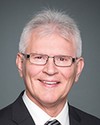Mr. Chairman and members of the committee, good morning. I wish to acknowledge that today we meet on Algonquin territory, land that has never been ceded or surrendered. I once again thank the Algonquin Nation for the privilege to meet here and speak specifically regarding our indigenous warrior veterans, while acknowledging all of our veterans, as well as members of the armed forces and the Royal Canadian Mounted Police.
Let me begin by offering sincere thanks to your committee for the announcement that you will be undertaking visits to some of our indigenous communities across a big part of Canada to gain knowledge and information regarding our distinguished indigenous veterans. This marks the first time that the Government of Canada has decided to seek first-hand information from our veterans, and we hope this will lead to a stronger understanding of the many issues faced by our veterans and in our communities.
AVA was hoping that the visits would have included more communities in all reaches of Canada—north, south, east, and west—but I also acknowledge this as being a very good starting point. I was just recently informed that later on this year you are undertaking plans to visit the north of Canada, which I think will be one of your biggest challenges. Again, meegwetch.
As president of the Aboriginal Veterans Autochtones, I once again appear here to represent the indigenous veterans from my organization and indigenous veterans from the Congress of Aboriginal Peoples and the Assembly of First Nations through a memo of understanding. This presentation is one that I feel has great significance, as it deals directly with indigenous veterans.
History reveals that as of the War of 1812, which was long before Canada became its own country, indigenous support was essential to the ultimate success of Canada achieving nationhood. Had the outcome of that particular conflict favoured the United States, the geography of Canada would certainly be different. Given that there was indigenous support, why was there a disconnect between these allies and the rest of Canada?
After Confederation, the crown was intent on assimilating the natives of Canada into a more Eurocentric society and away from the spiritual and cultural norms and practices. Even when treaties were enacted, these actions continued. Treaties, by definition, are agreements between sovereign nations. What happened? Reserves were created, with government controls, through the development of the Indian Act. Residential schools were created to assimilate our children and youth, to outlaw native spirituality, and to replace it with Christian ideals. Included in this was the banning of all cultural practices by our peoples.
How does this actually have anything to do with our veterans? At the start of both world wars and the Korean War, indigenous warriors enrolled to fight for the crown. The number of indigenous people who enrolled and fought represented the highest percentage of any Canadian demographic. The reason for enrolment may have been as simple as getting three meals a day, a pair of boots, or a bed to sleep in. I tend to think the main reason was to show that indigenous people were willing to once again prove their steadfastness to Canada, while at the same time hoping that by serving, things would change and become better back home. In other words, it meant my service in exchange for the country recognizing my rights and respecting me as an equal.
I was honoured to be present at both the Italian campaign's and the Dieppe raid's 75th commemorations. At these, I spoke and listened to veterans who knew of indigenous warriors in their own units, some of whom are buried in these foreign lands, and some who returned after the fighting was over. At Dieppe, during a sunrise ceremony, I was witness to the emotional atmosphere of this terrible raid and the senseless loss of life suffered on that beach. On that beach, let it be known that there was a high number of first nations and Métis veterans, especially from the South Saskatchewan Regiment. Vast numbers were killed, and others were interned in POW camps until the end of the war.
Let's refer back to my earlier comments regarding residential schools. What about indigenous soldiers fighting overseas? How about the soldier fighting in Italy, while back at home the residential school director shows up with the police at his place and takes his five-year-old son away from his wife and takes that little boy to residential school? Think about you and your own children. What would you do? Where would you turn? In the case of that young woman, there was nowhere to turn; it was the law.
Also, on return after both wars, non-indigenous veterans were offered land grants, cut-rate loans, and other benefits, not to mention whatever Veterans Affairs had at that time for benefits. The Government of Canada used this time as another chance to disenfranchise returning indigenous veterans.
Also of note, Indian Affairs considered indigenous veterans as falling under their jurisdiction and not Veterans Affairs Canada's, with little or no benefits. I can only say that if you look, you will see that our warriors were equal in battle but discriminated against at home. This attitude has continued for many years, and even today with the recent media coverage, it still exists. In my notes, you'll see some of the most recent things that I've mentioned.
It is not the intention of our indigenous veterans to be classed alone; rather, we take pride in service to Canada and service with all Canadian veterans. With them, we stand united.
On previous appearances here at this committee, I advocated for our rural and isolated communities regarding veterans and establishing sound mechanisms for communicating with them with respect to those benefits and entitlements that they should have. The technology enjoyed by mainstream Canadians is not necessarily the norm in remote communities. Since my last appearance here over a year ago, there has been little traction towards addressing the issue of our veterans living in remote areas.
I take note that you will be looking for answers as to what the communities offer in a transition process. You must understand that in the case of first nations, the health care budgets on reserves are limited, and they cannot be expected to add care for our veterans without a direct and positive influence by the Government of Canada and in particular by Veterans Affairs. I can also say that the same issues exist in smaller communities where other indigenous veterans reside. You'll be visiting one of those on your trip.
Are the services that are being offered actually reaching out to remote communities? That is a question that is not easily answered. I have a great deal of concern regarding some of the excellent programs instituted recently by Veterans Affairs Canada, such as the education benefit and caregiver's entitlement. My concern is that communicating those benefits to remote areas or regions and offering up these incentives may very well not be reaching out far enough.
OSISS is an outstanding organization that has done excellent work. Does it, however, have the ability to do outreach to our indigenous veterans who are suffering from mental issues? Is there any way to provide outreach mental health services to rural communities too far away to access somebody in person, including the OSISS organization? What mechanisms can be instituted by Veterans Affairs Canada, in conjunction with the health care community professionals, specifically for veterans?
In other words, assuring care for entitled veterans should not become a financial burden on any community from the money received for the health of the community. Veterans Affairs must establish the same and equal support as for mainstream veterans, including any costs associated with that support.
I noted in your travel agenda that you wanted to know specific issues regarding veterans from all three of the indigenous groups in Canada.
The issue for some first nations veterans is that their military service may not have been with Canada but rather with the U.S. military, in other words, with an allied force. Although I understand and appreciate that the U.S. DVA holds responsibility for their benefits, there appears to be a disconnect concerning the way these veterans can access the benefits they are entitled to through the DVA hospital system.
I was informed four years ago by Chief Percy Joe from the Shackan Indian Band, a remote reserve near Merritt, B.C., that veterans had to pay out of their pockets the expenses to get from their community to the border; then they would be covered. I asked at that time whether there was a possibility of an agreement between DVA and VAC to address and resolve the issue of travel, in other words, whether there was a way that Veterans Affairs could pay that travel and be reimbursed by DVA, that is, through cross-border talks.
Concerning Inuit veterans, including veterans of the Canadian rangers, travel to remote northern communities is not included on your initial agenda. I know that the next leg of your journey will include northern Inuit communities, and this will be extremely important, for as we know, in Canada the highest suicide rates are among our indigenous peoples, and this is more the case within Inuit communities. With the announcement by VAC and DND of a suicide prevention strategy, I am hopeful that this will also include interaction with indigenous social workers, with the intention of reducing the numbers of suicide deaths, be they of veterans or not.
Regarding RCMP veterans who are receiving benefits and entitlements from VAC, my nephew, a first nations status Indian from Oromocto First Nation, has stated that he has not had any problems with Veterans Affairs or anyone he has been in contact with in that department.
Once again, I offer these words: effective communication is the cornerstone to success, for if you can communicate your message to everyone and it is understood, then you have achieved the most important step in providing care to veterans.
Mr. Chairman, committee members, and fellow veterans, thank you, meegwetch, marsi, merci, qujannamiik, all my relations.




